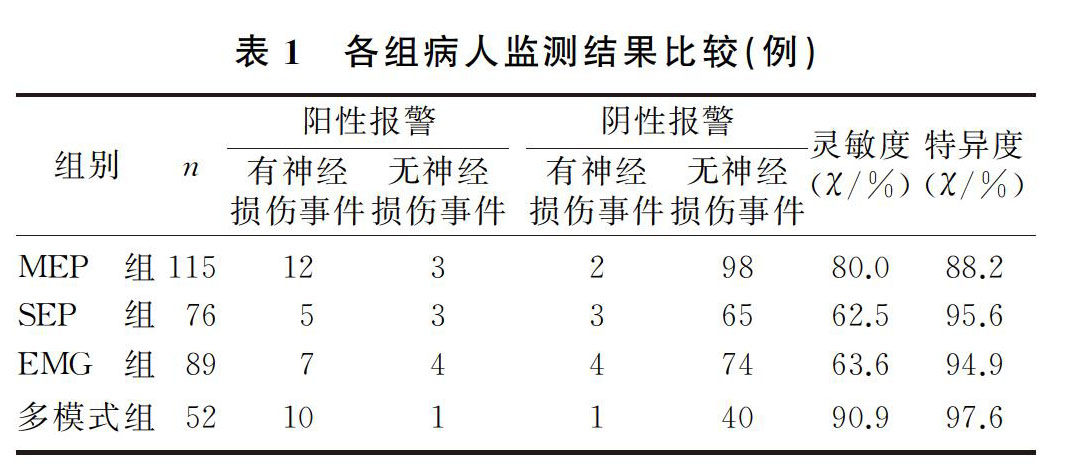多模式术中监测对脊柱手术效果的影响

打开文本图片集
[摘要]目的探討多模式术中监测对脊柱手术效果影响,并分析神经系统监测变化的潜在危险因素。方法选取脊柱外科手术病人120例,术中进行神经电生理监测,其中115例行运动诱发电位(MEP)监测(MEP组),76例行体感诱发电位(SEP)监测(SEP组),89例行肌电图(EMG)监测(EMG组),52例对上述3种电位均进行监测(多模式组)。记录各组术中报警和神经损伤事件发生情况。结果MEP组术中神经监测报警灵敏度为85.7%,特异度88.2%;SEP组灵敏度为62.5%,特异度95.6%;EMG组灵敏度为63.6%,特异度94.9%;多模式组灵敏度为90.9%,特异度97.6%;多模式组灵敏度和特异度均高于其他3组(χ2=3.92~7.83,P<0.05)。15例神经功能缺损病人中,1例出现永久性神经功能损伤,6例出现短暂的神经功能损伤,8例出现可逆的神经功能损伤。在术前神经监测中,有截骨术、Cobb角≥90°病人发生报警的比例显著高于无截骨术、Cobb角<90°病人(χ2=7.00、5.16,P<0.05)。结论多模式术中监测可提高脊柱手术神经损伤监测的敏感性,截骨术和Cobb角≥90°是神经系统监测变化的潜在危险因素。
[关键词]监测,手术中;脊柱疾病;神经电生理监测
[中图分类号]R619[文献标志码]A[文章编号] 2096-5532(2018)06-0672-05
EFFECT OF MULTIMODAL INTRAOPERATIVE MONITORING ON THE OUTCOME OF SPINAL SURGERY RAO Shanshan, XU Shuang, SHANG Hui (Department of Spine Surgery, Shiyan Taihe Hospital, Shiyan 442000, China)
[ABSTRACT]ObjectiveTo investigate the effect of multimodal intraoperative monitoring on the outcome of spinal surgery and the potential risk factors for changes in neurological monitoring. MethodsA total of 120 patients who underwent spinal surgery were eolled, and neurophysiological monitoring was performed during surgery. Among these patients, 115 underwent motor evoked potential (MEP) monitoring (MEP group), 76 underwent somatosensory evoked potential (SEP) monitoring (SEP group), 89 underwent electromyography (EMG) monitoring (EMG group), and 52 underwent MEP, SEP, and EMG monitoring (multimodal group). Intraoperative alarms and nerve injury events were recorded. ResultsThe sensitivities and specificities of intraoperative nerve monitoring alarm in the MEP, SEP, EMG, and multimodal groups were 85.7%/88.2%, 62.5%/95.6%, 63.6%/94.9%, and 90.9%/97.6%, respectively, and the multimodal group had significantly higher sensitivity and specificity than the other three groups (χ2=3.92-7.83,P<0.05). Among the 15 patients with neurological defects, 1 had permanent nerve injury, 6 had transient nerve injury, and 8 had reversible nerve injury. During preoperative neuromonitoring, the patients who underwent osteotomy or had a Cobb angle of ≥90° had a significantly higher proportion of patients with alarms than those who did not undergo osteotomy or had a Cobb angle of <90° (χ2=7.00 and 5.16,P<0.05). ConclusionMultimodal intraoperative monitoring can improve the sensitivity of nerve injury monitoring during spinal surgery, and osteotomy and a Cobb angle of ≥90° are potential risk factors for changes in neurological monitoring.
[KEY WORDS]monitoring, intraoperative; spinal diseases; neurophysiological monitoring
相关热词搜索: 脊柱 监测 多模 手术 效果热门文章:
- 关于某县森林防火宣传“五进...2023-12-26
- 2024年xx市主题教育动员会上讲话2023-12-26
- 2024年度有关市人大在市直机...2023-12-26
- XX市发改委领导关于“修六心...2023-12-26
- 2024年经验做法:三大举措精...2023-12-26
- 2024年XX区长在区委主题教育...2023-12-26
- (合集)关于纪检监察干部教...2023-12-25
- 2024年度石油化工企业消防安...2023-12-25
- 加强和改进农村消防安全工作...2023-12-25
- (24篇)办公厅、办公室“三...2023-12-25
相关文章:
- 布氏杆菌性脊柱炎的CT表现2022-10-23
- 环保局监测站年度工作总结及...2021-10-31
- 关于建设我国国家节水灌溉试...2022-02-25
- 手术室护理对骨科手术院内感...2021-08-27
- 手术室护理工作术前访视重要...2021-08-27
- 中医理论对手术室整体护理影响2021-08-27
- 质量控制对手术室护理管理质...2021-08-27
- 中医医院手术室工作计划2021-08-27
- 手术室工作总结2021-09-08
- 手术室护士工作总结2021-09-11
- 风险管理理论手术室护理管理价值2021-10-24
- 县医院手术室半年工作总结2021-11-01
- 医院手术室护理心得体会2021-12-26
- 卫生执法法律效果与社会效果...2021-10-21
- 国有商业银行实行专业化集中...2021-11-15
- 人事劳动和社会保障局开展民...2021-12-15
- “创新激励”效果好2022-01-30
- 学习超市收获大效果好2022-02-13
